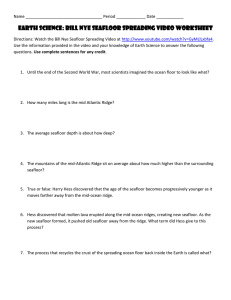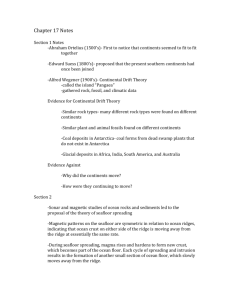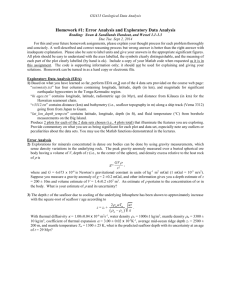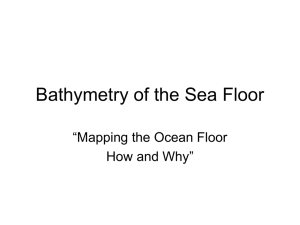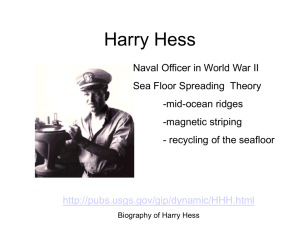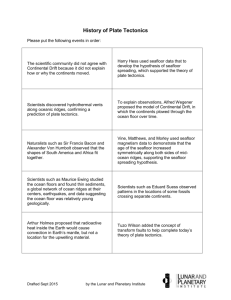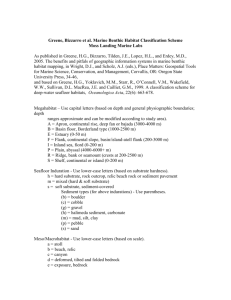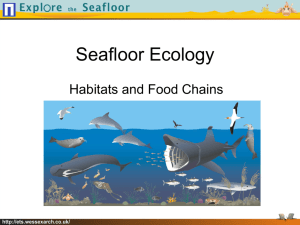Memo 1: Curriculum Review of NOAA Module on Seafloor Mapping
advertisement
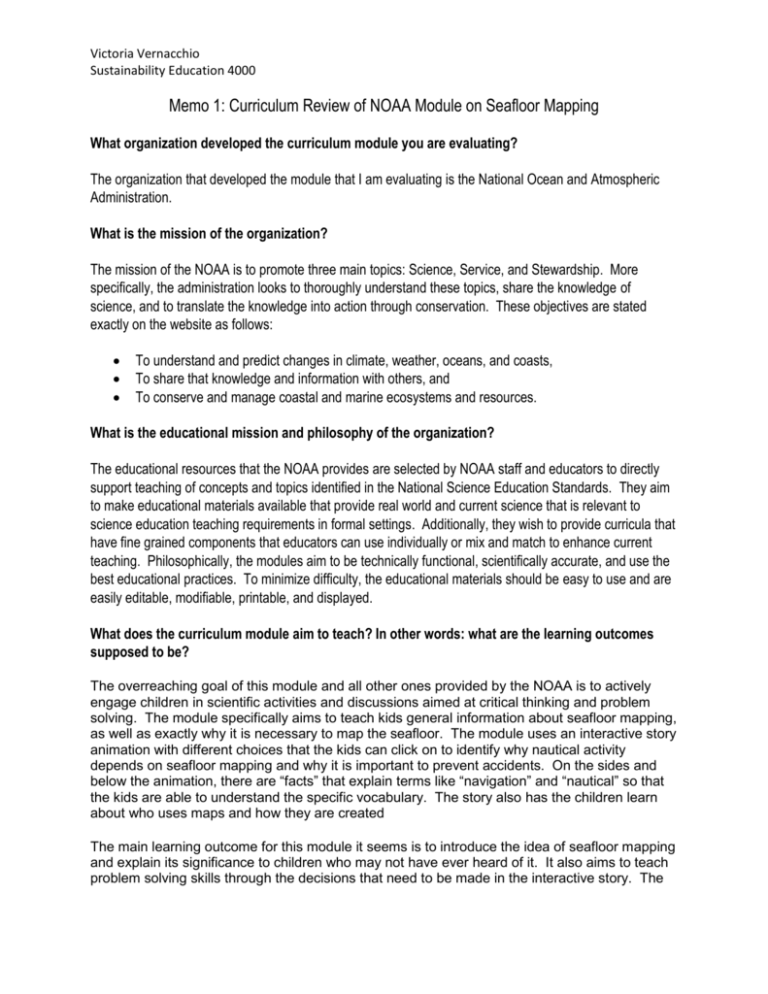
Victoria Vernacchio Sustainability Education 4000 Memo 1: Curriculum Review of NOAA Module on Seafloor Mapping What organization developed the curriculum module you are evaluating? The organization that developed the module that I am evaluating is the National Ocean and Atmospheric Administration. What is the mission of the organization? The mission of the NOAA is to promote three main topics: Science, Service, and Stewardship. More specifically, the administration looks to thoroughly understand these topics, share the knowledge of science, and to translate the knowledge into action through conservation. These objectives are stated exactly on the website as follows: To understand and predict changes in climate, weather, oceans, and coasts, To share that knowledge and information with others, and To conserve and manage coastal and marine ecosystems and resources. What is the educational mission and philosophy of the organization? The educational resources that the NOAA provides are selected by NOAA staff and educators to directly support teaching of concepts and topics identified in the National Science Education Standards. They aim to make educational materials available that provide real world and current science that is relevant to science education teaching requirements in formal settings. Additionally, they wish to provide curricula that have fine grained components that educators can use individually or mix and match to enhance current teaching. Philosophically, the modules aim to be technically functional, scientifically accurate, and use the best educational practices. To minimize difficulty, the educational materials should be easy to use and are easily editable, modifiable, printable, and displayed. What does the curriculum module aim to teach? In other words: what are the learning outcomes supposed to be? The overreaching goal of this module and all other ones provided by the NOAA is to actively engage children in scientific activities and discussions aimed at critical thinking and problem solving. The module specifically aims to teach kids general information about seafloor mapping, as well as exactly why it is necessary to map the seafloor. The module uses an interactive story animation with different choices that the kids can click on to identify why nautical activity depends on seafloor mapping and why it is important to prevent accidents. On the sides and below the animation, there are “facts” that explain terms like “navigation” and “nautical” so that the kids are able to understand the specific vocabulary. The story also has the children learn about who uses maps and how they are created The main learning outcome for this module it seems is to introduce the idea of seafloor mapping and explain its significance to children who may not have ever heard of it. It also aims to teach problem solving skills through the decisions that need to be made in the interactive story. The Victoria Vernacchio Sustainability Education 4000 module also provides a more well-rounded knowledge of general ocean practices with boat safety tips and facts about the U.S. Coast Guard. Do you think the curriculum is appropriately designed to produce the intended learning outcomes? Generally, yes the curriculum is appropriately designed. I think that the interactivity of the story is crucial to achieving the intended learning outcomes. This activity, though, is intended to be completed on an individual level, and even though the story is interactive, to absorb the appropriate amount of information to fulfill the learning outcomes there is a large amount of reading involved. Especially for a topic that is not as familiar or captivating like seafloor mapping, the children may not have the attention span to read through all of the information on each page. Not fully reading the blocks of information on each page would limit the fulfillment of the learning outcomes, which is one of the only downsides I see in this module. This module is effective, however, in providing a number of other resources to supplement the interactive story for either the teacher or the individual student to take advantage of. These related resources include two movies, websites, a podcast, books to be found in the library, and websites to visit. To combat the issue of students becoming bored, the module includes three different and informative games that children can easily find and play right on the website. For teachers, the module provides a substantial number of workshops and activities targeted at different age groups that will also contribute to the children fulfilling the outcomes of problem solving, critical thinking, and even design. While the interactive story alone does not fulfill the goals, the plethora of other resources to supplement the information reaches almost all areas of learning for the kids. Does this curriculum teach the kind of literacies the EcoEd Research Group advocates? This module certainly focuses on certain EcoEd literacy goals more than others. In fact, it seems to be only targeted on just a few due to the specificity of the topic that it covers. In completing the interactive story and briefly scanning through the multitude of other resources, it seems that the variety of sources available really teaches the goal of “having creative info-seeking practices, animated analytic capabilities, and a capacity to narrate a complex chain of events.” The module is clearly designed for the student to peruse the sources on their own time. The workshops and activities seem to focus on designing specific functioning systems like boats, volcanoes, or systems in a bottle, which emphasizes their skills identifying complex causation and how each small part plays a role in the greater functioning of a system. Additionally, I believe that many of the activities are group activities, which helps them “understand the challenges and value of cooperative action.” That said, I think that this module misses out on a large portion of EcoEd’s literacy goals that focus more on political and social influences on science and the functioning of society and law. For example, nothing in this module informs a child about political bias, understanding government, or choosing a diverse set of sources that may not have a scientific consensus. This module also does not really focus on the individual’s health or well-being, or their own actions and how they could have an effect on the environment. This module focuses more on understanding the science and functioning of the environment rather than how the individual or society influences it. Victoria Vernacchio Sustainability Education 4000 What could be layered into this curriculum so that it addresses more of the learning outcomes that the EcoEd Group advocates? Because of the lack of coverage regarding any kind of social issue regarding oceans or seafloor mapping, I think that some kind of movie or discussion relating to an environmental issue needs to be put into the curriculum. For example, a short video about endangered whale species may only be loosely related but it introduces the idea of human and environmental interaction. Another idea would be to add on a discussion to the “Make an Edible Coral Reef” activity about what coral reefs need to survive (like the chart we did in class) and how they could be positively or negatively impacted by human activity. In that discussion, there would be room to discuss laws that prevent pollution into the ocean to cover a basic level of understanding of government. The interactive story hints at the idea of disaster by illustrating a boat crash because of no seafloor mapping, but I think that another component needs to be added to the module to more clearly outline the history of disaster and decision-making failures. Perhaps a more thorough coverage of the need for seafloor mapping through historical events like large crashes or major discoveries that would be exciting to the children would fill this gap. This module can be found at the following URL: http://oceanservice.noaa.gov/education/seafloor-mapping/welcome.html
